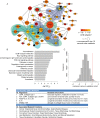Integrative network analysis highlights biological processes underlying GLP-1 stimulated insulin secretion: A DIRECT study
- PMID: 29293525
- PMCID: PMC5749727
- DOI: 10.1371/journal.pone.0189886
Integrative network analysis highlights biological processes underlying GLP-1 stimulated insulin secretion: A DIRECT study
Abstract
Glucagon-like peptide 1 (GLP-1) stimulated insulin secretion has a considerable heritable component as estimated from twin studies, yet few genetic variants influencing this phenotype have been identified. We performed the first genome-wide association study (GWAS) of GLP-1 stimulated insulin secretion in non-diabetic individuals from the Netherlands Twin register (n = 126). This GWAS was enhanced using a tissue-specific protein-protein interaction network approach. We identified a beta-cell protein-protein interaction module that was significantly enriched for low gene scores based on the GWAS P-values and found support at the network level in an independent cohort from Tübingen, Germany (n = 100). Additionally, a polygenic risk score based on SNPs prioritized from the network was associated (P < 0.05) with glucose-stimulated insulin secretion phenotypes in up to 5,318 individuals in MAGIC cohorts. The network contains both known and novel genes in the context of insulin secretion and is enriched for members of the focal adhesion, extracellular-matrix receptor interaction, actin cytoskeleton regulation, Rap1 and PI3K-Akt signaling pathways. Adipose tissue is, like the beta-cell, one of the target tissues of GLP-1 and we thus hypothesized that similar networks might be functional in both tissues. In order to verify peripheral effects of GLP-1 stimulation, we compared the transcriptome profiling of ob/ob mice treated with liraglutide, a clinically used GLP-1 receptor agonist, versus baseline controls. Some of the upstream regulators of differentially expressed genes in the white adipose tissue of ob/ob mice were also detected in the human beta-cell network of genes associated with GLP-1 stimulated insulin secretion. The findings provide biological insight into the mechanisms through which the effects of GLP-1 may be modulated and highlight a potential role of the beta-cell expressed genes RYR2, GDI2, KIAA0232, COL4A1 and COL4A2 in GLP-1 stimulated insulin secretion.
Conflict of interest statement
Figures


References
-
- Mehta A, Marso SP, Neeland IJ. Liraglutide for weight management: a critical review of the evidence. Obes Sci Pract. 2016; doi: 10.1002/osp4.84 - DOI - PMC - PubMed
-
- Simonis-Bik AMC, Eekhoff EMW, De Moor MHM, Kramer MHH, Boomsma DI, Heine RJ, et al. Genetic influences on the insulin response of the beta cell to different secretagogues. Diabetologia. 2009;52: 2570–2577. doi: 10.1007/s00125-009-1532-3 - DOI - PubMed
-
- Schäfer SA, Tschritter O, Machicao F, Thamer C, Stefan N, Gallwitz B, et al. Impaired glucagon-like peptide-1-induced insulin secretion in carriers of transcription factor 7-like 2 (TCF7L2) gene polymorphisms. Diabetologia. 2007;50: 2443–2450. doi: 10.1007/s00125-007-0753-6 - DOI - PMC - PubMed
-
- Sathananthan A, Man CD, Micheletto F, Zinsmeister AR, Camilleri M, Giesler PD, et al. Common genetic variation in GLP1R and insulin secretion in response to exogenous GLP-1 in nondiabetic subjects: a pilot study. Diabetes Care. 2010;33: 2074–6. doi: 10.2337/dc10-0200 - DOI - PMC - PubMed
-
- Schäfer SA, Müssig K, Staiger H, Machicao F, Stefan N, Gallwitz B, et al. A common genetic variant in WFS1 determines impaired glucagon-like peptide-1-induced insulin secretion. Diabetologia. 2009;52: 1075–82. doi: 10.1007/s00125-009-1344-5 - DOI - PubMed
Publication types
MeSH terms
Substances
Grants and funding
LinkOut - more resources
Full Text Sources
Other Literature Sources
Medical
Molecular Biology Databases
Miscellaneous

